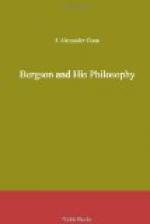Our ordinary conception of Time, that which comes to us from the physical sciences, is, Bergson maintains, a false one. It is false because so far from being temporal in character, it is spatial. We look upon space as a homogeneous medium without boundaries; yet we look on Time too, as just such another medium, homogeneous and unlimited. Now here is an obvious difficulty, for since homogeneity consists in being without qualities, it is difficult to see how one homogeneity can be distinguished from another. This difficulty is usually avoided by the assertion that homogeneity takes two forms, one in which its contents co-exist, and another in which they follow one another. Space, then, we say, is that homogeneous medium in which we are aware of side-by-sideness, Time—that homogeneous medium in which we are aware of an element of succession. But this surely we are not entitled to maintain, for we are then distinguishing two supposed homogeneities by asserting a difference of quality in them. To do so is to take away homogeneity. We must think again and seek a way out of this difficulty. Let us admit space to be a homogeneous medium without bounds. Then every homogeneous medium without bounds must be space. What, then, becomes of Time?—for on this showing, Time becomes space. Yes, says Bergson, that is so, for our common view of Time is a false one, being really a hybrid conception, a spurious concept due to the illicit introduction of the idea of space, and to our application of the notion of space, which is applicable to physical objects, to states of consciousness, to which it is really inapplicable. Objects occupying space are marked out as external to one another, but this cannot be said of conscious states. Yet, in our ordinary speech and conventional view of things, we think of conscious states as separated from one another and as spread out like “things,” in a fictitious, homogeneous medium to which we give the name Time. Bergson says, “At any rate, we cannot finally admit two forms of the homogeneous, Time and Space, without first seeking whether one of them cannot be reduced to the other. Now, externality is the distinguishing mark of things which occupy space, while states of consciousness are not essentially external to one another and become so only by being spread out in Time regarded as a homogeneous medium. If, then, one of these two supposed forms of the homogeneous, viz., Time and Space, is derived from the other, we can surmise a priori that the idea of space is the fundamental datum. Time, conceived under the form of an unbounded and homogeneous medium, is nothing but the ghost of space, haunting the reflective consciousness.” [Footnote: Time and Free Will, p. 98 (Fr. p. 75).] Bergson remarks that Kant’s great mistake was to take Time as a homogeneous medium. [Footnote: Time and Free Will, p. 232 (Fr. p. 178).]




